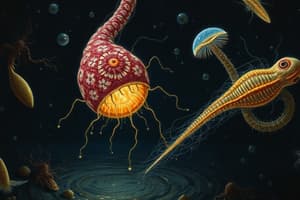Podcast
Questions and Answers
Which of the following is NOT a bacterial pathogen included in the differential diagnosis of histolytica intestinal amebiasis?
Which of the following is NOT a bacterial pathogen included in the differential diagnosis of histolytica intestinal amebiasis?
- Vibrio cholerae (correct)
- Escherichia coli
- Salmonella
- Shigella
What is the typical dosage of metronidazole for adults with intestinal amoebiasis?
What is the typical dosage of metronidazole for adults with intestinal amoebiasis?
- 500 to 750 mg orally 3 times a day for 7 to 10 days (correct)
- 2000 mg orally 3 times a day for 7 to 10 days
- 125 mg orally 3 times a day for 7 to 10 days
- 1000 mg orally 3 times a day for 7 to 10 days
Which of the following is a characteristic of Entamoeba coli cysts?
Which of the following is a characteristic of Entamoeba coli cysts?
- They have 8 nuclei and splinter-like chromatoid bodies. (correct)
- They contain a single chromatoid body.
- They have a smooth, rounded shape.
- They have a single nucleus.
What is NOT a preventive measure for Entamoeba histolytica infection?
What is NOT a preventive measure for Entamoeba histolytica infection?
What is the name of the medication commonly used as first-line treatment for Entamoeba histolytica infections?
What is the name of the medication commonly used as first-line treatment for Entamoeba histolytica infections?
Which of these is NOT listed as a possible differential diagnosis for extra-intestinal amebiasis caused by E. histolytica?
Which of these is NOT listed as a possible differential diagnosis for extra-intestinal amebiasis caused by E. histolytica?
What is the name of the stage of Entamoeba coli that has a sluggish movement and short, extended pseudopodia?
What is the name of the stage of Entamoeba coli that has a sluggish movement and short, extended pseudopodia?
Which of the following is NOT a characteristic of Entamoeba coli trophozoites?
Which of the following is NOT a characteristic of Entamoeba coli trophozoites?
What characterizes the Trophozoite stage of Entamoeba coli in comparison to Entamoeba histolytica?
What characterizes the Trophozoite stage of Entamoeba coli in comparison to Entamoeba histolytica?
How can one differentiate the cyst of Entamoeba coli from that of Entamoeba histolytica?
How can one differentiate the cyst of Entamoeba coli from that of Entamoeba histolytica?
What is a characteristic of Entamoeba gingivalis?
What is a characteristic of Entamoeba gingivalis?
What kind of contact is involved in the transmission of Entamoeba gingivalis?
What kind of contact is involved in the transmission of Entamoeba gingivalis?
What type of vacuoles are commonly found in the Trophozoite of Entamoeba gingivalis?
What type of vacuoles are commonly found in the Trophozoite of Entamoeba gingivalis?
What is the term used for the cytoplasmic extensions that allow Amoeba to change shape and move?
What is the term used for the cytoplasmic extensions that allow Amoeba to change shape and move?
Which stage do Amoeba primarily reproduce by binary fission?
Which stage do Amoeba primarily reproduce by binary fission?
What is a common characteristic of protozoa?
What is a common characteristic of protozoa?
What reproductive process occurs in some protozoal species like Sporozoa?
What reproductive process occurs in some protozoal species like Sporozoa?
During which environmental conditions do Amoeba typically form an encysted stage?
During which environmental conditions do Amoeba typically form an encysted stage?
Which part of the Amoeba's cytoplasm is primarily responsible for its movement?
Which part of the Amoeba's cytoplasm is primarily responsible for its movement?
What does the term 'Amoeba' derive from?
What does the term 'Amoeba' derive from?
What is the main method through which Amoeba engulf food?
What is the main method through which Amoeba engulf food?
What is the diagnostic stage of protozoa called?
What is the diagnostic stage of protozoa called?
How do protozoa in the Class Rhizopoda primarily move?
How do protozoa in the Class Rhizopoda primarily move?
Which of the following protozoa is known to be pathogenic?
Which of the following protozoa is known to be pathogenic?
What are cysts in protozoa primarily characterized by?
What are cysts in protozoa primarily characterized by?
Which of the following is NOT classified as an intestinal amoeba?
Which of the following is NOT classified as an intestinal amoeba?
What type of environment is Entamoeba histolytica more commonly found in?
What type of environment is Entamoeba histolytica more commonly found in?
What is the primary method of multiplication for Trophozoites in protozoa?
What is the primary method of multiplication for Trophozoites in protozoa?
Which free-living amoeba is associated with causing meningoencephalitis?
Which free-living amoeba is associated with causing meningoencephalitis?
What form of E. histolytica is primarily responsible for invasiveness in the host?
What form of E. histolytica is primarily responsible for invasiveness in the host?
Which route is the most common for the transmission of amoebic cysts?
Which route is the most common for the transmission of amoebic cysts?
What is a characteristic symptom of amoebic dysentery?
What is a characteristic symptom of amoebic dysentery?
What happens to amoebic cysts in the stomach after ingestion?
What happens to amoebic cysts in the stomach after ingestion?
During the life cycle of E. histolytica, where do trophozoites invade to cause disease?
During the life cycle of E. histolytica, where do trophozoites invade to cause disease?
Which of the following statements is NOT true regarding the cysts of E. histolytica?
Which of the following statements is NOT true regarding the cysts of E. histolytica?
What are the clinical features of Intestinal Amoebiasis during the incubation period?
What are the clinical features of Intestinal Amoebiasis during the incubation period?
What term describes the lesions caused by trophozoites invading the colonic mucosa?
What term describes the lesions caused by trophozoites invading the colonic mucosa?
What presents as intense colicky pain, rectal tenesmus, and more than 20 motions per day?
What presents as intense colicky pain, rectal tenesmus, and more than 20 motions per day?
In which type of stool would trophozoites typically be found?
In which type of stool would trophozoites typically be found?
Which clinical feature is NOT associated with amoebic abscesses?
Which clinical feature is NOT associated with amoebic abscesses?
What is the primary method for diagnosing intestinal amoebiasis?
What is the primary method for diagnosing intestinal amoebiasis?
Which investigation method is specifically NOT useful for demonstrating trophozoites?
Which investigation method is specifically NOT useful for demonstrating trophozoites?
Which of the following is a characteristic of amoebic appendicitis?
Which of the following is a characteristic of amoebic appendicitis?
Which serological test can be used for diagnosing amoebic infections?
Which serological test can be used for diagnosing amoebic infections?
What is a common symptom of amoebic abscesses in extra-intestinal locations?
What is a common symptom of amoebic abscesses in extra-intestinal locations?
Flashcards
Protozoa
Protozoa
Unicellular eukaryotic microorganisms with no cell walls.
Amoeba
Amoeba
A single-celled organism that can change its shape.
Pseudopodia
Pseudopodia
Cytoplasmic extensions used for movement and feeding in amoebas.
Binary Fission
Binary Fission
Signup and view all the flashcards
Trophozoite Stage
Trophozoite Stage
Signup and view all the flashcards
Encysted Stage
Encysted Stage
Signup and view all the flashcards
Ectoplasm
Ectoplasm
Signup and view all the flashcards
Endoplasm
Endoplasm
Signup and view all the flashcards
Entamoeba histolytica
Entamoeba histolytica
Signup and view all the flashcards
Bacterial pathogens
Bacterial pathogens
Signup and view all the flashcards
Preventive measures for E.histolytica
Preventive measures for E.histolytica
Signup and view all the flashcards
First-line treatment for amebiasis
First-line treatment for amebiasis
Signup and view all the flashcards
Entamoeba coli
Entamoeba coli
Signup and view all the flashcards
Entamoeba coli life cycle stages
Entamoeba coli life cycle stages
Signup and view all the flashcards
Symptoms of intestinal amebiasis
Symptoms of intestinal amebiasis
Signup and view all the flashcards
Cyst structure in Entamoeba coli
Cyst structure in Entamoeba coli
Signup and view all the flashcards
Trophozoites
Trophozoites
Signup and view all the flashcards
Amoebic cysts
Amoebic cysts
Signup and view all the flashcards
Mode of Infection
Mode of Infection
Signup and view all the flashcards
Life cycle of E. histolytica
Life cycle of E. histolytica
Signup and view all the flashcards
Intestinal Amoebiasis
Intestinal Amoebiasis
Signup and view all the flashcards
Amoebic dysentery
Amoebic dysentery
Signup and view all the flashcards
Virulence factors
Virulence factors
Signup and view all the flashcards
Extraintestinal Amoebiasis
Extraintestinal Amoebiasis
Signup and view all the flashcards
Amoebic appendicitis
Amoebic appendicitis
Signup and view all the flashcards
Fulminant colitis
Fulminant colitis
Signup and view all the flashcards
Amoebic abscess
Amoebic abscess
Signup and view all the flashcards
Stool examination
Stool examination
Signup and view all the flashcards
Stool antigen detection
Stool antigen detection
Signup and view all the flashcards
Serology
Serology
Signup and view all the flashcards
Molecular diagnosis
Molecular diagnosis
Signup and view all the flashcards
E. gingivalis
E. gingivalis
Signup and view all the flashcards
Ingested particles in E. coli
Ingested particles in E. coli
Signup and view all the flashcards
Transmission of E. gingivalis
Transmission of E. gingivalis
Signup and view all the flashcards
Cyst
Cyst
Signup and view all the flashcards
Pathogenic Amoebae
Pathogenic Amoebae
Signup and view all the flashcards
Nonpathogenic Amoebae
Nonpathogenic Amoebae
Signup and view all the flashcards
Class Rhizopoda
Class Rhizopoda
Signup and view all the flashcards
Free-living Amoebae
Free-living Amoebae
Signup and view all the flashcards
Study Notes
Protozoa Overview
- Protozoa are single-celled eukaryotic microorganisms.
- They lack cell walls.
- Many protozoa live singly, some in colonies.
- Only a few are pathogenic to humans.
Protozoa Reproduction
- Asexual reproduction: Mitotic binary fission produces two new daughter cells from one parent cell.
- Sexual reproduction: Meiotic process, occurs in some species like Sporozoa.
Amoeba Characteristics
- Amoeba is a single-celled protozoan that changes shape continuously.
- Pseudopodia are cytoplasmic extensions that allow movement and engulfing of food (phagocytosis).
- Amoeba has an outer ectoplasm layer and an inner endoplasm layer.
- They multiply by binary fission when conditions are favorable.
- Many species form cysts for survival during unfavorable conditions, transfer to new hosts
Classification of Clinically Important Protozoa
- Classified based on mode of locomotion and site of infection.
- Amoebas move using extensions.
- Flagellates use whip-like structures.
- Ciliates use cilia beating.
- Sporozoans are non-motile in adult form.
- Intestinal: Entamoeba histolytica, Giardia lamblia, Cryptosporidium parvum, Trichomonas vaginalis
- Blood & tissues: Plasmodium, Toxoplasma gondii, Trypanosoma, Leishmania
Entamoeba histolytica
- Worldwide, more common in warm regions.
- Three subspecies: E. dispar, E. moshkovskii, E. bangladeshi.
- Causes amoebic dysentery (intestinal) and amoebic liver abscess.
- Has a trophozoite and cyst stage.
- Trophozoite multiplies in the intestines, eventually cysts are formed to survive unfavorable conditions.
- Humans get infected through ingesting cysts in contaminated food/water.
- Diagnosis: microscopic, stool culture, antigen tests, serology, and molecular.
Entamoeba coli
- Cosmopolitan (found worldwide).
- Two stages: Trophozoite and cyst.
- Trophozoite doesn’t invade the intestinal mucosa, non-pathogenic.
- Has 8 nuclei in the cyst stage..
Entamoeba gingivalis
- Primarily found in the oral cavity of humans and other mammals.
- Only the trophozoite stage is known.
- Non-pathogenic but can ingest bacteria, leukocytes, and erythrocytes.
- Transmission by oral-oral contact.
Lifecycle of E. histolytica
- Infectious form: mature quadrinucleated cyst.
- Cyst passes through the stomach, digestive enzymes break the cyst wall, and it transforms to the trophozoite.
- Trophozoite multiplies in intestines, causing tissue damage and diarrhea (dysentery).
- Cysts are formed and passed out in feces, completing the cycle
Prevention & Treatment of E. histolytica
- Avoidance of ingesting contaminated food and water.
- Treatment with metronidazole or similar drugs.
Pathogenesis of Amebiasis
- Intestinal amoebiasis: Trophozoites invade colonic mucosa, causing ulcerative lesions and bloody diarrhea.
- Extraintestinal amoebiasis: (e.g. liver abscess) involves the spread via blood to other organs.
Studying That Suits You
Use AI to generate personalized quizzes and flashcards to suit your learning preferences.




